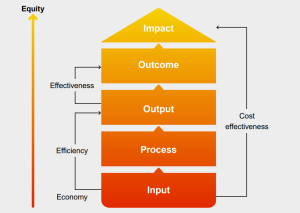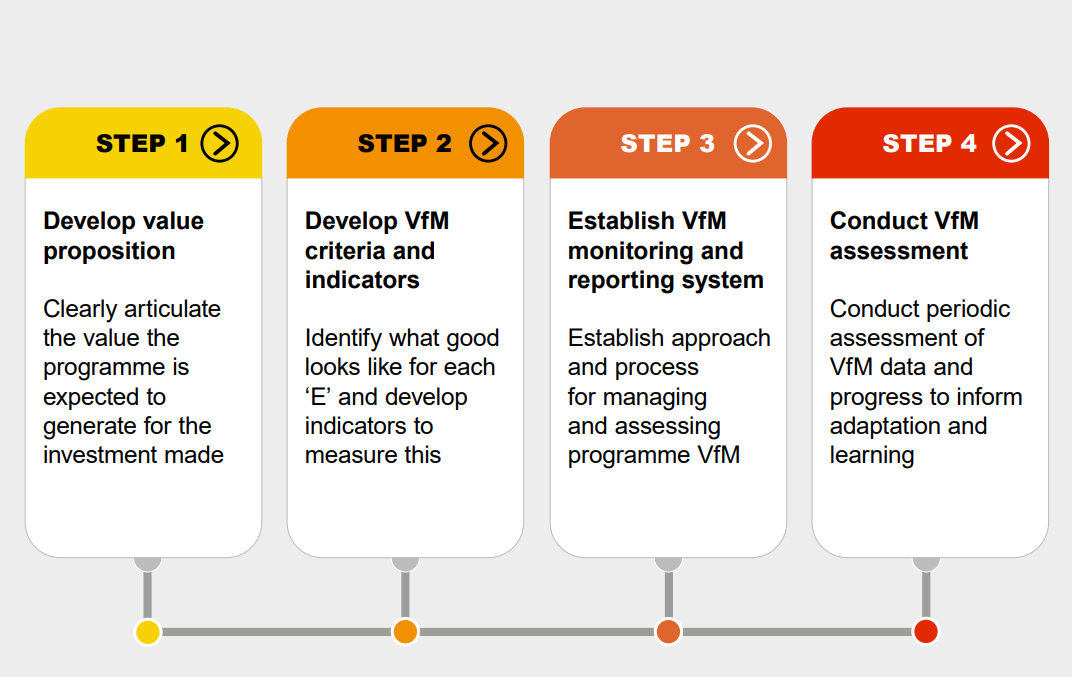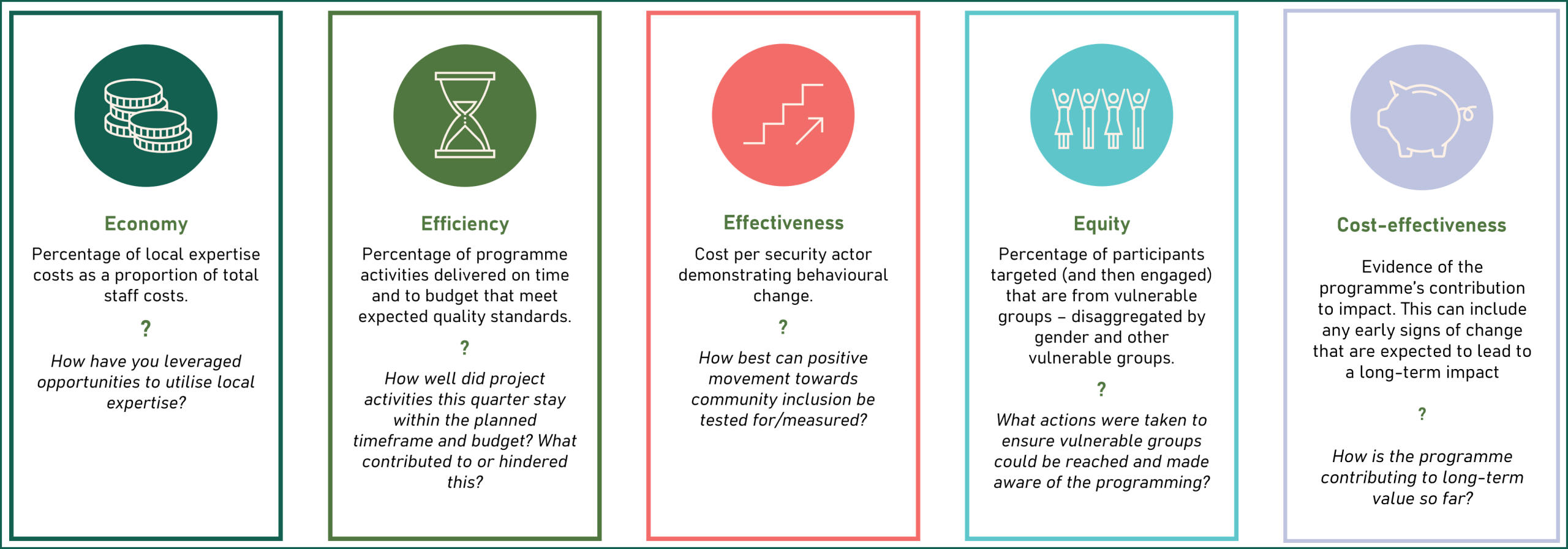With international development budgets under scrutiny, it’s more important than ever for decision-makers to understand the VfM of their programme investments.
This two-part blog explores why tracking and assessing VfM matters, and how to do it in a proportionate, practical way that supports informed decision-making. Drawing on our work with the UK Integrated Security Fund (ISF) Africa portfolio, we share insights, real-world examples, and actionable guidance from our newly launched VfM toolkit.
What is VfM and why does it matter?
At its core, VfM is about making the most of available resources to achieve the greatest possible impact.

Measuring VfM is not a one-off exercise – it’s a continuous process of monitoring and evaluating how resources are used to ensure investments deliver strong results. This is typically assessed against the ‘5Es’: economy, efficiency, effectiveness, equity, and cost-effectiveness.
Crucially, VfM isn’t about cutting costs at the expense of quality.
It’s about striking the right balance – allocating resources wisely to maximise outcomes and long-term impact.
When managed well, VfM generates:
- Learning to improve programme delivery and effectiveness;
- Evidence to guide future programming and resource allocation;
- Assurance to ministers, the public, and international partners about the value of our investments.
Step-by-step guide to monitoring and measuring VfM
Itad has been working with the UK Integrated Security Fund (ISF) (formerly the UK Conflict, Stability and Security Fund) for the last decade. The ISF invests in programming at home and overseas to tackle some of the most complex national security challenges facing the UK and its partners.
In 2023, we developed and piloted a VfM toolkit in collaboration with ISF programme teams across the Africa portfolio. The toolkit offers a straightforward, practical approach to embedding VfM into programme monitoring, evaluation and learning (MEL) systems.
The toolkit supports the generation of VfM evidence to inform learning, drive adaptive management and ultimately help the portfolio maximise the impact of its investments.
While the toolkit was developed with ISF programme teams in mind, its principles and practical steps apply to any programme or organisation seeking to assess and demonstrate the VfM of their investments.
Four steps to build your VfM framework
A VfM framework provides a structured approach to planning, implementing, and evaluating VfM within a programme. Our toolkit outlines a simple four-step process for programme teams – complete with practical examples of what good looks like.

Step 1: Develop a value proposition
Start with a clear, concise statement outlining the benefits your programme aims to deliver and who they are intended for. This forms the foundation for assessing the expected value of your investment (see page 9 of the toolkit for an example of this).
Step 2: Develop VfM criteria and indicators
Define what ‘good VfM’ looks like across the 5Es: economy, efficiency, effectiveness, equity, and cost-effectiveness. You may also want to consider additional dimensions such as sustainability, adaptability, or coherence.
Once expectations are clear, develop a small set of VfM indicators to track progress and assess whether your programme continues to deliver value over time.

Step 3: Establish a system to monitor and report on VfM
Create simple, practical tools to collect data on your VfM indicators and track progress over time. Regular monitoring and reporting help programme teams reflect on performance, identify areas for improvement and adjust as needed to stay on course.
Step 4: Conduct periodic VfM assessments
Carry out in-depth reviews of all available evidence related to your programme’s VfM. These assessments support evidence-based decision-making, helping to improve delivery and impact, guide future programming and resource allocation, and demonstrate value to donors, stakeholders, and the wider public.
Barriers to demonstrating VfM
While the ‘5Es’ framework aligns well with ISF programming, the complexity of the contexts in which ISF operates presents inherent challenges to demonstrating VfM. Key barriers include:
The nature of ISF programming
ISF programmes are often short-term, high-risk interventions designed to support a mix of cross-government strategic objectives.
When developing criteria for what good programme VfM looks like, it is important to account for the risk and the limits of what can be achieved in a limited time, and to consider a range of objectives a programme intends to support.
The operating context
ISF programmes are delivered in dynamic, high-risk, and often conflict-affected environments. These settings demand an adaptive approach to VfM – one that focuses on the aspects of delivery most responsive to changing conditions and capable of adapting when things aren’t working.
The nature of programme benefits
The primary purpose of the ISF is to support UK national security. Programmes are designed to contribute to strategic, long-term benefits for the UK, often through building political access and influence (PAI); many interventions are also catalytic by design, aiming to trigger further change beyond the life of the programme.
As a result, qualitative VfM assessment is essential – not only to evidence the value of these strategic outcomes, but also to capture progress toward longer-term and potentially transformational goals.
What makes a good VfM framework?
Through our work with ISF teams across Africa and globally, we’ve identified several key features that make programme VfM frameworks most effective:
Promote collaboration
Developing and implementing a VfM framework should involve all those contributing to programme delivery. This ensures shared ownership and keeps the focus on demonstrating value at the core of implementation.
Align with programme theory and strategic objectives
A strong VfM framework is grounded in the programme’s theory of change and clearly articulates how anticipated benefits contribute to broader strategic objectives. It should evolve as the programme adapts.
Integrate with M&E processes
Embedding VfM within existing M&E processes strengthens decision-making. For example, combining VfM and results monitoring in a Programme Performance Dashboard enables teams to draw on complementary data for better evidence-based decisions.
Allow for flexibility
The toolkit’s steps are designed to be simple and adaptable, not prescriptive. Teams should use the approaches and tools that best suit their context, which increases the likelihood of the framework being used and useful.
Enable light-touch reflection and learning
Regular reflection on VfM is important, but it doesn’t need to be resource-intensive. We have found that integrating short, frequent check-ins into existing reporting and learning processes helps sustain a focus on VfM, even in time-pressured environments.
Apply proportionately
Gathering new VfM evidence should be guided by utility and effort. Focus on areas that are likely to yield actionable insights, and make the most of existing data and results monitoring systems to avoid duplication.
Use qualitative evidence
Qualitative insights are a valuable complement to quantitative VfM indicators. They help explain not just what is happening, but why, adding depth and context to your assessments
What else can you do to strengthen VfM management?
The VfM toolkit offers a clear and practical starting point for developing a VfM framework – but effective VfM management goes beyond the framework itself.
Based on our experience, programme teams can further strengthen their approach by:
- Planning ahead to identify the right moments for conducting VfM assessments – ideally aligned with key decision points in the programme cycle.
- Investing in training and mentoring to help teams and implementers integrate VfM thinking into existing M&E and reporting processes.
- Advocating for the use of VfM evidence – especially among senior decision-makers – by showing how it can support smarter, more accountable decisions
In our next blog, we’ll explore how to get the most value from a VfM assessment, with practical tips for ensuring the findings meaningfully inform decision-making.
Let’s Keep the Conversation Going
Are you working on developing a VfM framework or trying to improve the way your programme demonstrates value? We’d love to hear from you.
Whether you’re just starting out or looking to build on your existing VfM approach, get in touch (via LinkedIn or BlueSky) to discuss challenges, share experiences, or explore collaboration opportunities.

